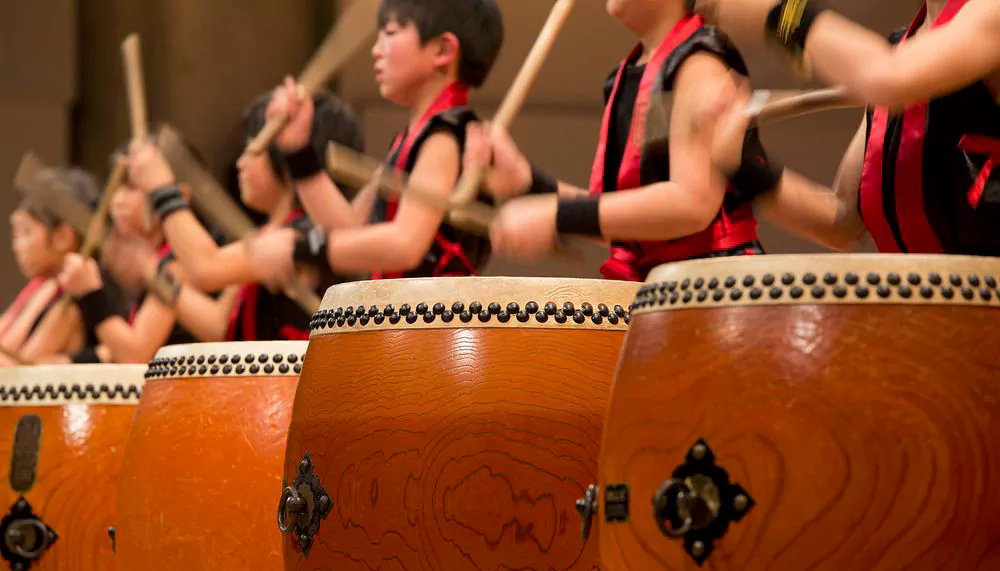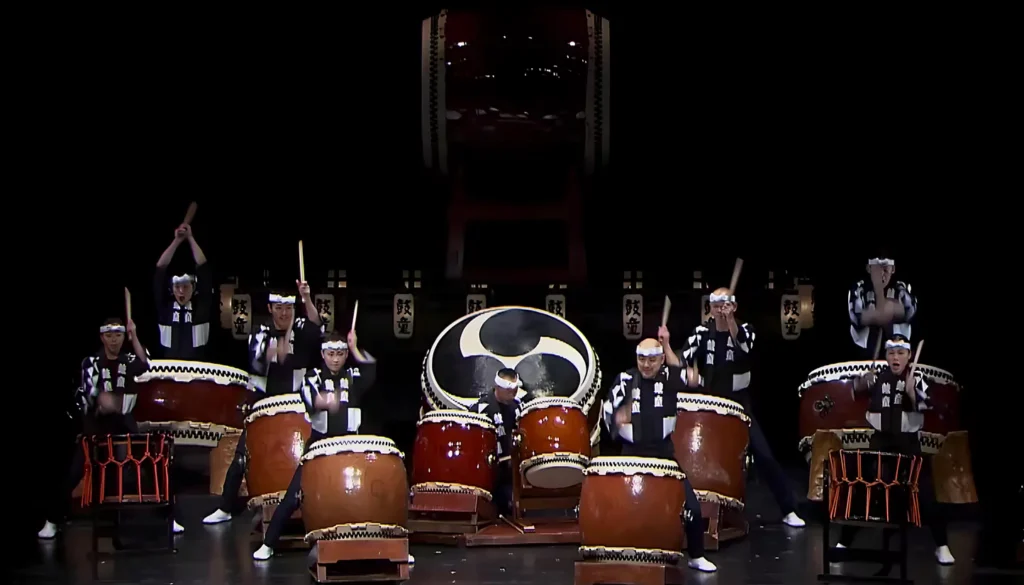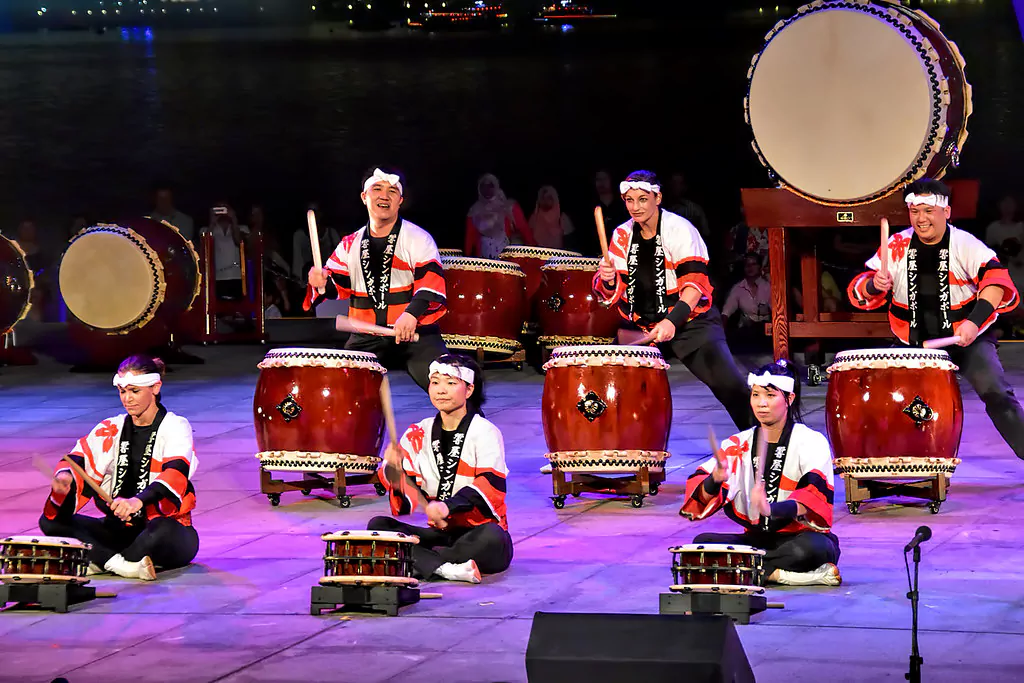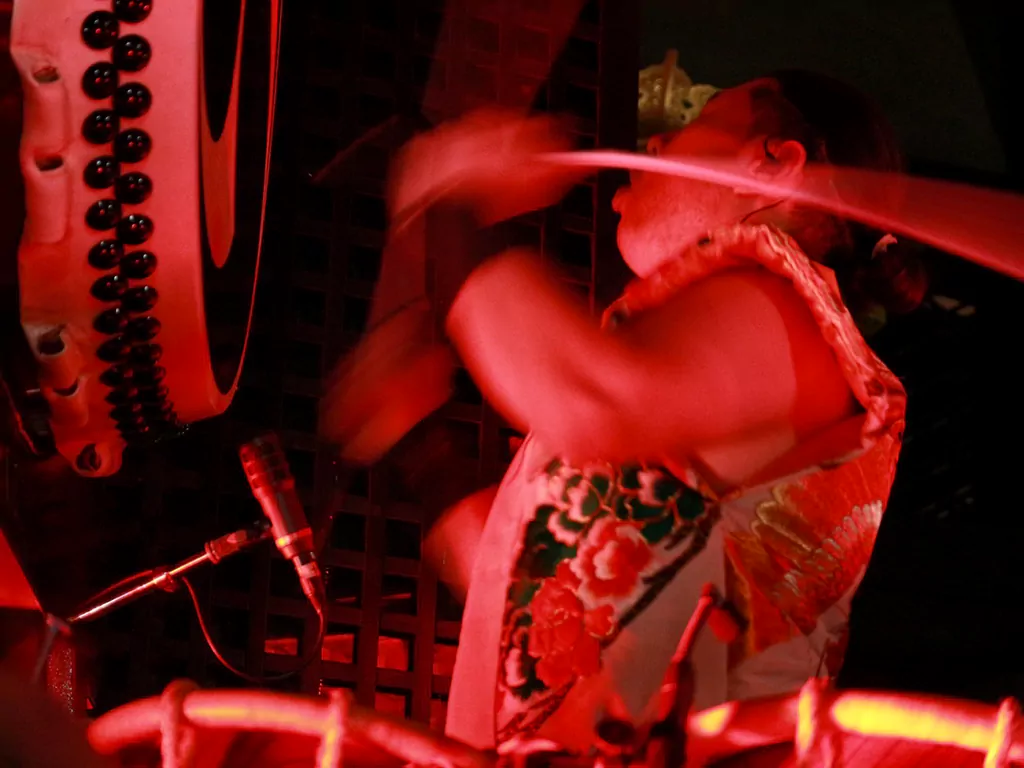Taiko, the traditional art of Japanese drumming, is recognised and revered worldwide for its powerful sound, visual dynamism and cultural significance. No longer confined to the sphere of religious rituals, festivals, and community performances, taiko is now a diverse and vibrant art form practiced around the world by musicians, teachers, and community members. In the past few decades, taiko music has also been making strides towards financial viability with music production, licensing, brand partnership, and creative entrepreneurship. This paper examines the commercial channels of taiko music, considering existing business methods, issues of intellectual property rights, brand partnerships, and the potential for sustainable economic growth in the contemporary creative industries.

Taiko Today in the New Schools
It wasn’t just the folkloric and communal aspect of ritual taiko drumming, but its spiritual dimension. Since at least the late 20th century, however, a new generation of groups—first Kodo, later Ondekoza, and still later, TAIKOPROJECT and Tao—turned the drumming into a performance art worthy of a theater stage, so that many people experienced taiko performances in a way they never had: in cultural festivals or temples. This move towards commercialisation then paved the way to more wide-ranging commercial possibilities.
Modern taiko groups perform internationally (they even record CDs), collaborate with top 40 acts, and create their own merchandise and educational materials. These are the forms culture of preservation and market engagement meet.
Taiko Music Production and Distribution
Recording and Album Releases
Taiko groups have been releasing studio albums more and more, with the discs featuring a depth of traditional rhythms and also new-school compositions. The commercial potential lies in:
Streaming platforms: By publishing taiko music on platforms like Spotify, Apple Music, and YouTube Music, taiko has more opportunities for people to be able to hear it, and ideally help the art form generate income for having the music digitally played.
Physical media: CDs and vinyl records work as both merchandise and collectors pieces for fans.
Live albums, concert recordings: These items are an archival memory of the immersive experience of a taiko performance and sellable digital content.

Groups like Kodo and Yamato have been able to put out professionally produced, widely distributed albums in a variety of countries. That income is not the only value such albums generate for taiko: They lend authority to taiko’s profile as a world musical force.
Licensing and Synchronization
Licensing and Synch Licensing and sync are huge ways to grow business. “Taiko” has what Aplin calls a “film score sensibility,“ and has become a favorite among composers for film, video games, commercials and trailers.
Film/TV scoring: Taiko rhythms are regularly used to add tension and drama. Film studios or production houses, one or two of which a band may blanket with licensing, can make lucrative deals.
Action and strategy video games frequently contain taiko elements. Original music or sample packs are also sought for game developers.
Advertising: Taiko is employed for product launches, event ads and brand campaigns in the hopes of being noticed for bold rhythmic impact.
Managing music rights through PROs and digital licensing platforms (like AudioJungle or Epidemic Sound) let taiko artists control usage and recoup royalties.
Intellectual Property and Rights Management
As taiko music increases in lucrative value, IP is key to know and protect.
Copyrighting of Compositions: With original taiko pieces a composer can copyright his work, providing a safeguard against misuse.
Trademark group names and logos: to assure brand identity and avoid misusing.
Contracts, licensing: Be specific about what’s allowed, royalties and attribution.
Finally, taiko groups simply need to be informed about basic IP issues and to seek legal advice when orchestrating licensing or commercial deals. This is in the interest of fair remuneration and the long-term protection of works of art.

Merchandise and Branding
One opportunity for taiko groups to develop an income is by merchandising. Popular products include:
Clothing: T-shirts, hoodies and performance uniforms featuring group logos or Japanese calligraphy.
Instruments and accessories: Personalized drumsticks, bachi cases, own-brand practice pads.
Price: Instructional DVDs, Printed scores and Online course subscriptions.
An effective one-ballerown visual presence – cohesive brand across social media, product and promo – will increase your brand recognition and attract loyal customers.
Brand Collaborations and Sponsorships
In addition, by working with other brands or industries, taiko groups can reach out further and tap into new markets.
Fashion and Lifestyle Brands
The aesthetics of Taiko fits well with fashion and lifestyle branding. Collaborations could involve:
Performance-inspired clothing lines
Japanese-inspired limited-edition merchandise
Cross-branded apparel or accessories
Automotive and Technology Sectors
The strong, kinetic energy of taiko suits branding for cars, motorcycles, electronics and sports gear.” Taiko’s campaigns can convey power, precision and progress.

Cultural and Tourism Boards
Taiko performances are frequently sponsored by the tourism bureau to attract tourists and to hopefully underwrite the retinue of the performers. Working with these entities promotes the cultural mission of taiko, as well as bringing commercial exposure and funding.
Educational Services as a Business Model
Taiko education is cultural evangelism and a way to make a living both.
Community Classes and Workshops
Regular classes provide ongoing revenue, drive deep community involvement. The sites are schools, community centers and private studios.
Online Courses and Virtual Programs
Online education platforms allow for access all over the world. (24)(25)(26) File video tutorials, live webinars, and subscription models make it so that taiko teachers can have a reach beyond the local community in terms of content provision.
Certification and Instructor Training
On the one hand, setting up formal certification programs will not only normalize the quality of outdoor instructors nationwide, but also generate a network of certified instructors who are certified to the mother organization.
Event Production and Touring
performance Taiko Productions -how taiko can be marketed as a specific type of performing group Another role of a Taiko ensemble is to serve as a business that provides a performance product and earns money in the markets in which it operates.. They make money using-1) performances (tour, performances) -2) recordings (t-shirt, website, etc.).
Ticketed shows and international tours
Festival bookings
Corporate events and private engagements

High professional productions values, marketing and audience engagement are necessities if touring is to continue. Other groups — like Drum Tao — have transformed their tours into theatrical events, drawing attention from the general public and big ticket sales.
Digital Marketing and Fan Engagement
The need of a strong digital identity in commerce:
Audience building is crucial, and social media sites including Instagram, YouTube, TikTok and Facebook are central.
Fan-submitted email newsletters keep devotees in the know about the events, releases and products.
Fans can support creative works directly through crowdfunding platforms (e.g., Patreon, Kickstarter).
Building a online fanbase can also help taiko groups supplement earnings through donations, digital content and merchandise.
Sustainable Development and Ethical Considerations
Commercialising the taiko not only opens up financial possibilities, but also requires the need for sensitive ethical and cultural consideration.
Cultural authenticity: Resisting commercialization that dilutes taiko’s cultural value or inaccurately reflects its traditions.

Fair pay: Guaranteeing all participants and contributors are provided with fair pay.
Environmental sustainability: WTF alternative in merchandise production, travel logistics, and instrument procurement.
Companies should be more explicit in stating they have a responsibility to balance profit with culture.
Strategic Recommendations for Sustainable Growth
For those who want to forge into an economically viable and culturally sensitive taiko business, groups should:
Create a DISTINCTIVE ARTIST IDENTITY: Establish an identity for the ensemble that sets if apart in the marketplace.
Diversify revenue streams: Blend performance, education, merchandise, and licensing offerings for financial stability.
Invest in training: Train members in marketing, production and digital skills.
Partnerships: You’ll forge collaborations with other brands, institutions and artists.
Forge a vision for the future: Cultivate steady expansion that respects heritage while embracing novelty.
Conclusion
The commercial potential of taiko music is an exciting frontier in which tradition and creativ imodernization intersect. With strategic investments in music production, licensing, branding, and education, taiko groups can develop artistically and grow the global impact of a potent cultural form. At the heart of it all is the pursuit of economic growth while maintaining cultural integrity, as the deafening thunderous sound of the taiko drum will emanate across the globe, inspiring just as it educates, and does so for centuries to come.



